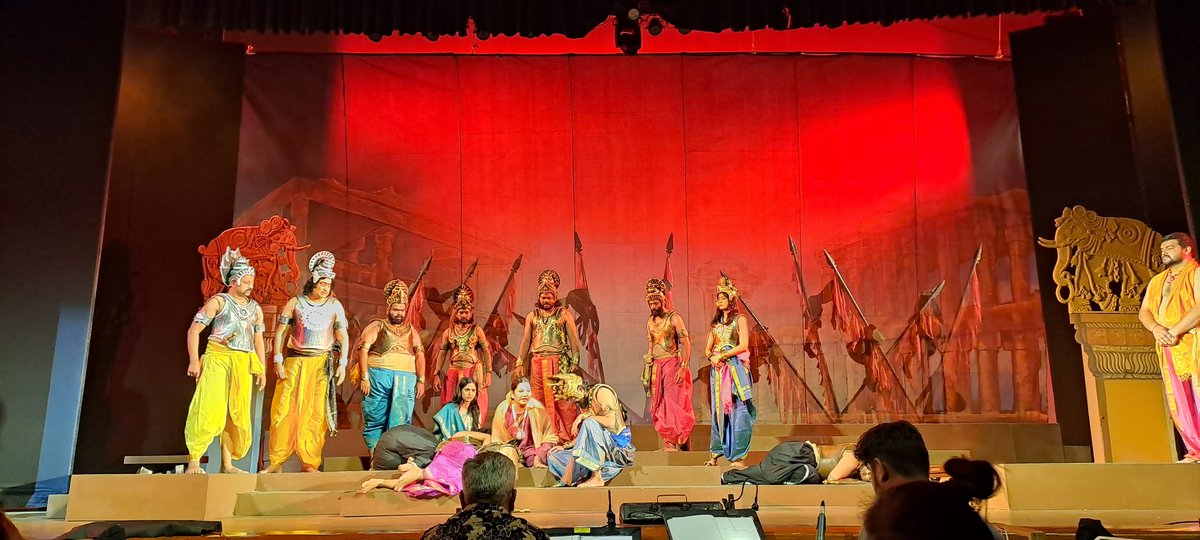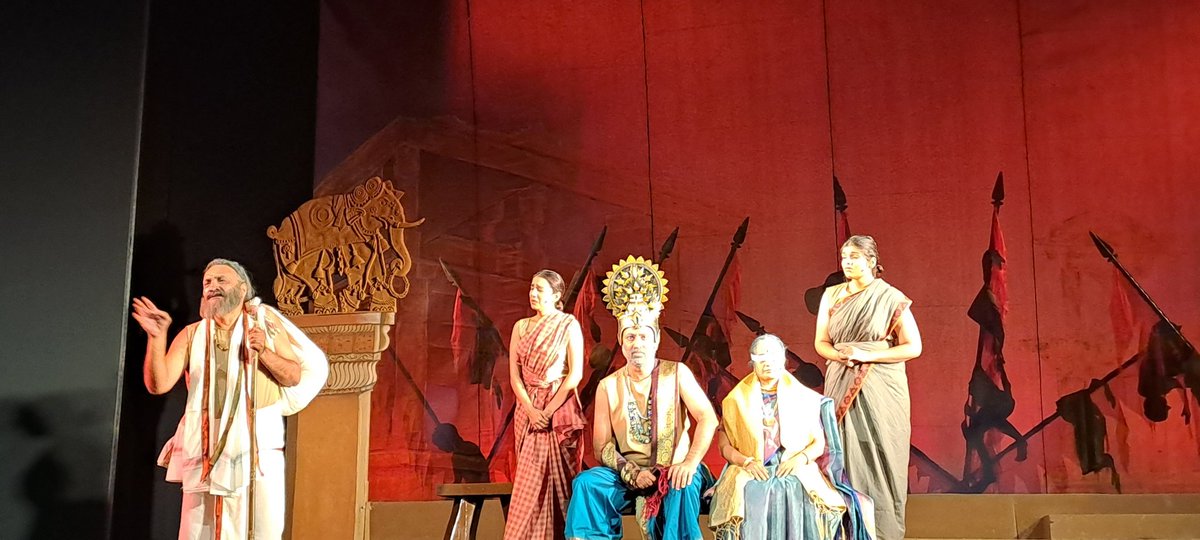How has Bharatavarsha come to be known for #Diversity? What is the nature of #Tolerance Hindus have? How do we view ‘Other’ #Faiths? Do the Bharateeya societies need to be managed from outside such as ‘Secularism’ so that we dont persecute others?
A #Thread !
+
A #Thread !
+
In order to respond to this, we need to start from the Civilizational fundamental - something that has remained constant throughout in all these centuries across all Bharateeya Communities.
Including the Jaina-s and Bouddha-s.
+
Including the Jaina-s and Bouddha-s.
+
‘Purushartha’ is that Civilizational fundamental common across centuries.
- All have rights to fulfil their needs/desires (Artha/Kama - AK)
- Resource limitation leads to AK-Conflicts
- Dharma resolves AK-Conflicts
- Dharma is created & sustained by our pursuit of the Sacred
+
- All have rights to fulfil their needs/desires (Artha/Kama - AK)
- Resource limitation leads to AK-Conflicts
- Dharma resolves AK-Conflicts
- Dharma is created & sustained by our pursuit of the Sacred
+
Now, this pursuit of Sacred is not some intellectual idea or desperate effort. In our Civilization, we have crafted systematic methods, orders, traditions, rituals, customs in this pursuit. There is a method to this madness to the pursuit of Sacred.
+
+
Every pursuit of Desire/Need was organized into a Kula/Jati with exclusively aligned Sacred practices.
Thus, every community
- anchored the creation of some material/experience/service for the rest of the society
- as internally organized with its own Spiritual practices
+
Thus, every community
- anchored the creation of some material/experience/service for the rest of the society
- as internally organized with its own Spiritual practices
+
What does this mean to #Diversity?
Every Community with its own Devata, Sacred Practices, Rituals, Material/Service Creation performances, interfaces with other Communities for material creation/distribution, profession aligned Shastras -meant an immense amount of Diversity.
+
Every Community with its own Devata, Sacred Practices, Rituals, Material/Service Creation performances, interfaces with other Communities for material creation/distribution, profession aligned Shastras -meant an immense amount of Diversity.
+
Thus, both the Philosophy/Ontology & the Social organization drove this diversity, sustained by healthy internal structuring of communities.
Every community was depended on others.
Imagine this as a complex non-planar graph where edges represent dependency and relationship.
+
Every community was depended on others.
Imagine this as a complex non-planar graph where edges represent dependency and relationship.
+
Does this mean that there was absolute harmony between communities?
No.
Human tendencies will push for some fundamentalism and intolerance. However, Ontology & Social organization & Traditions reigned this tendency towards harmony.
Yet, this was not sufficient.
+
No.
Human tendencies will push for some fundamentalism and intolerance. However, Ontology & Social organization & Traditions reigned this tendency towards harmony.
Yet, this was not sufficient.
+
The society further innovated. Every living place developed its own common social customs, traditions, rituals outside of material interfaces - anchored by an exclusive Devata.
Thus every living place required that all communities honour a common sacred entity - Devata.
+
Thus every living place required that all communities honour a common sacred entity - Devata.
+
This ensured that you bury any excessive intolerance tendency you develop from within your community orientation and consciousness.
Thus, The Hindu society evolved into one large complex without sacrificing diversity, building harmony & managing conflicts effectively.
+
Thus, The Hindu society evolved into one large complex without sacrificing diversity, building harmony & managing conflicts effectively.
+
Rest of the world hasn’t seen anything like this. There
1. No Othering here.
2. A tendency to integrate every community into this scheme of this by offering an exclusive Artha-Kama space, allowing the society to build its own Sacred order interfacing with other communities.
+
1. No Othering here.
2. A tendency to integrate every community into this scheme of this by offering an exclusive Artha-Kama space, allowing the society to build its own Sacred order interfacing with other communities.
+
Does this mean we absolutely didnt make any distinction at all with people & communities? No, we did.
1. Puranic conflicts with Asuras represent this.
2. Artha-Kama only people who refused to recognize the Sacred and hence Dharma were always fought and eliminated.
+
1. Puranic conflicts with Asuras represent this.
2. Artha-Kama only people who refused to recognize the Sacred and hence Dharma were always fought and eliminated.
+
Now, this anusaMdhAna (complex engagement) worked very well until 700AD.
We integrated a huge number of communites/peoples from across the world into Bharatavarsha through the Philosophy and Operating Mechanism explained above.
+
We integrated a huge number of communites/peoples from across the world into Bharatavarsha through the Philosophy and Operating Mechanism explained above.
+
Abrahamic Societies with a very distinct ‘Othering’ pose a significant challenge to this framework.
Starting 700AD we have a very complex engagement with them but using the very same framework.
+
Starting 700AD we have a very complex engagement with them but using the very same framework.
+
1. Engage
2. Try and Integrate
3. Fight
4. Reconcile
5. Keep at a distance
În these 5 steps a very complex engagement is going on - often in iterations, sometimes in blindness, sometimes in full realisation that there is no way forward and so on.
+
2. Try and Integrate
3. Fight
4. Reconcile
5. Keep at a distance
În these 5 steps a very complex engagement is going on - often in iterations, sometimes in blindness, sometimes in full realisation that there is no way forward and so on.
+
The last 1400 hundred years shows that there has always been a complex attempt to integrate the A-societies too by breaking them down into communities & locally integrate them. Sometimes successful, sometimes a failure.
Industrial Revolution & Colonialism makes it difficult.
+
Industrial Revolution & Colonialism makes it difficult.
+
In this scheme of this, the order is like this
- Integrate & harmonize
- Keep on Reconfiguring
- Tolerate
- Keep a distance
- Continuously fight
- Eliminate
Thus, Toleration is simply one helpless option for us. Not the main one.
+
- Integrate & harmonize
- Keep on Reconfiguring
- Tolerate
- Keep a distance
- Continuously fight
- Eliminate
Thus, Toleration is simply one helpless option for us. Not the main one.
+
Now, coming to Dhume’s question - do we need an external agency like Secularism to manage this dimension of Bharateeya Communities?
Absolutely No. Secularism does not recognize any of these internal abilities of Bharateeya Parampara/Society. It will rather destroy it.
+
Absolutely No. Secularism does not recognize any of these internal abilities of Bharateeya Parampara/Society. It will rather destroy it.
+
It seeks to manage Bharateeya Societies from outside just as though we are another Abrahamic entity. In that process, it unleashes far greater violence destroying all abilities of Bharateeya Communities to manage this conflict from within.
Its a harmonising process.
+
Its a harmonising process.
+
Thus, the challenge for Bharatavarsha today is
- Keep alive our internal abilities to manage this conflict
- Not let Secularism destroy this internal ability
- Not let pressures of this conflict to over-uniform society from within . That will be a push us towards Abrahamism.
+
- Keep alive our internal abilities to manage this conflict
- Not let Secularism destroy this internal ability
- Not let pressures of this conflict to over-uniform society from within . That will be a push us towards Abrahamism.
+
Hence, we have to have a very clear understanding of the source of our Diversity, our internal tools to handle these conflicts with Othering entities, the risks we face from within and from outside.
+
+
In absolute clarity we must refuse to hand over our agency to Secularism to manage our affairs.
However, with an intense focus we must safeguard that internal ability of ours to face challenging from Secularism & Othering entities.
+
However, with an intense focus we must safeguard that internal ability of ours to face challenging from Secularism & Othering entities.
+
That means these three elements
A. The complex Non-Planar graph structure
B. With strong nodes consisting of Sacred instruments
C. Strong interfaces between Communities.
END
A. The complex Non-Planar graph structure
B. With strong nodes consisting of Sacred instruments
C. Strong interfaces between Communities.
END
• • •
Missing some Tweet in this thread? You can try to
force a refresh









